Lease Renewal Agreement Template
Once the original lease term ends, the landlord and tenant are faced with a decision point—to end or continue the lease agreement. Should both choose the latter, a lease renewal agreement is needed to formalize the continuation of their contract. FormsPal’s free template can be used for both commercial and residential lease renewals.
However, signing lease renewal agreements does not necessarily mean that only the duration of the rental period is prolonged or changed. The agreement may also contain the new rental payment amount, additional house rules, or provisions for existing repairs.
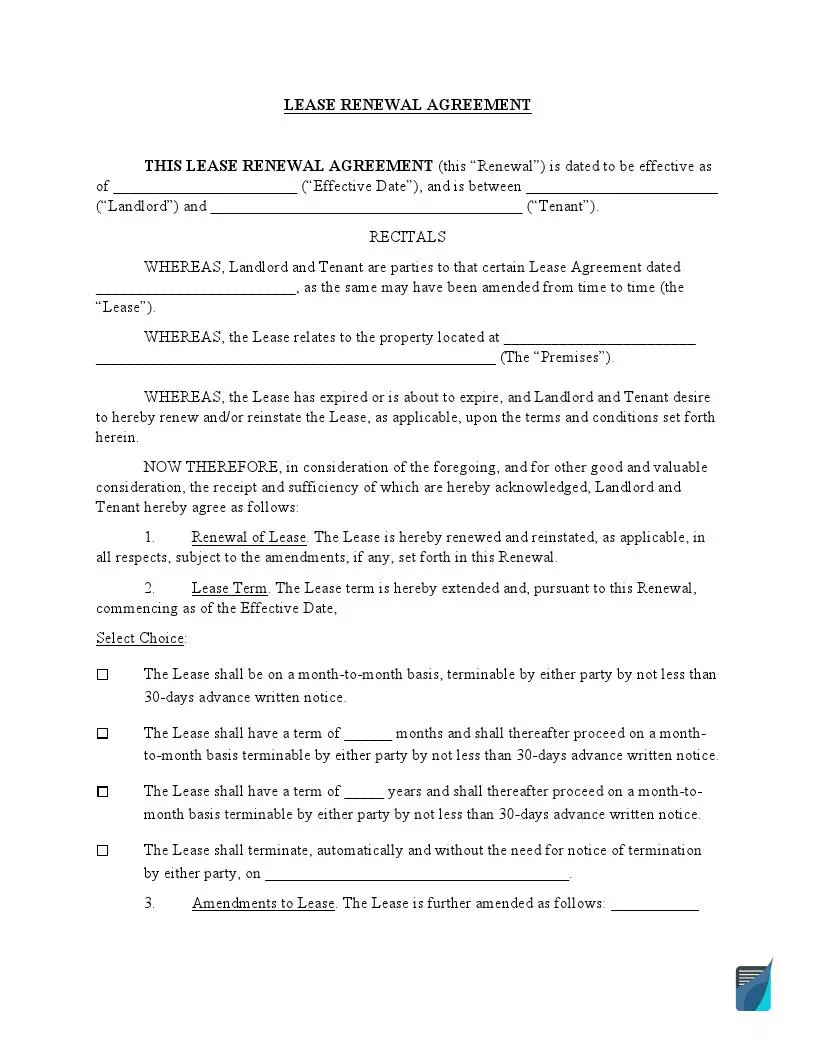
Build Your Document
Answer a few simple questions to make your document in minutes
Save and Print
Save progress and finish on any device, download and print anytime
Sign and Use
Your valid, lawyer-approved document is ready
When to Use a Lease Renewal
Contracts do not need to be renewed all the time. The landlord and tenant can, in fact, simply write a new lease. However, this will involve a lengthy process and several rounds of revision. Renewing a lease is the simpler solution if:
- the original lease, or prime lease, states that the lease can simply be renewed;
- there are minimal or no changes to the original lease. If there are many revisions, it is best to write a lease amendment;
- the tenant has consistently paid rent on time and caused no trouble;
- the landlord and tenant have a good ongoing relationship; or
- all provisions in the contract have been followed.
Simply using lease renewal agreements can definitely save time and effort, especially if you are merely continuing the majority of the provisions in the current lease.
Consequences of Not Using a Lease Renewal
Once a rental contract expires, both the tenant and landlord must renew the lease using a lease agreement. Without this document, either party can be prone to confusion, arguments, and financial losses.
Another glaring consequence of not using a lease renewal agreement is the contract’s automatic conversion into a “month-to-month” lease agreement. In this type of set-up, the provisions, payment, and rules may change periodically.
This will leave the tenant at a disadvantage because he or she may:
- lose money due to rent increase or pay moving costs if it doesn’t work out;
- lack security, since there is a monthly uncertainty regarding his or her house or unit; and
- waste time on having to look for new leases or undergo monthly negotiations with the current landlord.
The landlord, on the other hand, can negotiate high rates, but will need to:
- undergo stressful monthly negotiations with the tenant;
- lose money if the previous one leaves and the property is left vacant;
- waste time looking for a new tenant; and
- oversee monthly repairs from damages caused by every new tenant.
To dodge this dilemma, both the tenant and the landlord may use the lease renewal agreement available below. Not only will this save time and money, but it will also put you at ease knowing that both parties will keep their word based on the original contract and not on a tricky month-to-month lease agreement.
Renewal vs. Extension
A lease renewal is often associated with an extension. However, these two are completely different.
A lease renewal is regarded as a new contract wherein you may negotiate the monthly rent amount and change some rules. It is simply a new lease based on the old one.
A lease extension, on the other hand, will only change the expiration date of the contract without touching anything else. Landlords may even extend the contract up to an entire year.
Depending on your needs, you may choose from either of the above options. However, renewing your lease is the better option, since it allows changes to be made. If you simply want to use a lease extension, the monthly rent will not rise and updated rules cannot be legally binding.
How to renew a Lease?
Step 1— Notify the other party.
Since you have already established a good landlord-tenant relationship, it is best to talk with the other party before drafting an agreement. The reason for this is because the landlord or the tenant may prefer a different approach to the renewal. They may opt for a simple extension, an entirely different agreement, or the lease renewal agreement below.
This notice can be done either verbally or in writing depending on what you prefer. To renew a lease, you may also send a lease renewal letter stating your intent. Make sure you add your updated contact information so that the other party can reach you to discuss. Lastly, this letter must be sent at least 30 to 60 days before the existing contract expires to give you ample time to draft the new formal agreement.
Step 2— Fill out the renewal agreement.
If the tenant or the landlord gives the go-signal to proceed with the lease renewal, you may use the template available below. Make sure to fill out all the necessary information before sending the lease renewal form to the landlord or the tenant.
Alternatively, the tenant and the landlord may meet up to discuss, write, and sign the new agreement. In such a case, there is no need for a lease renewal letter. The landlord and the tenant may directly draft the renewal agreement.
Step 3— Send the document.
After undergoing negotiations and revisions, you may send the finalized lease renewal form to the other party for them to sign. Make sure to prepare copies, since both the landlord and the tenant must have a copy of the final document. Make an extra one for notarization.
If the signatory to the contract lives in a different city or state, you may send the contract via mail. It is crucial to have the original signature of both the landlord and tenant on all the copies.
Step 4— Notarize the document
Lastly, the landlord will be filing the agreement. Just like the original agreement, notarization is a must for documentation purposes. This also ensures that all the conditions set forth on paper become legally binding. However, there is no need to notarize the lease renewal letter that states your intent. Only notarize once the actual lease renewal agreement is finalized and fully signed.
All of these must be done before the current lease expires so that there will be no gap between the two agreements and there will be no breach of the lease terms if ever the tenant stays on the premises past the expiry.
Lease Renewal Agreement Form Details
| Document Name | Lease Renewal Agreement Form |
| Other Names | Renewal of Lease Agreement, Residential Lease Renewal |
| Avg. Time to Fill Out | 9 minutes |
| # of Fillable Fields | 28 |
| Available Formats | Adobe PDF |
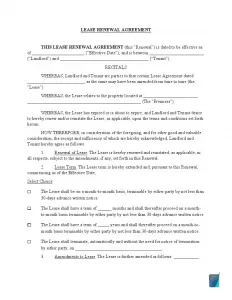
Filling Out the Renewal Agreement
Step 1— Download the lease termination letter template.
Download the document that is compatible with your computer:
- Lease Renewal Agreement Template – Adobe Format (.pdf)
- Lease Renewal Agreement Template – Microsoft Office Format (.docx)
Step 2— Fill out the basics.
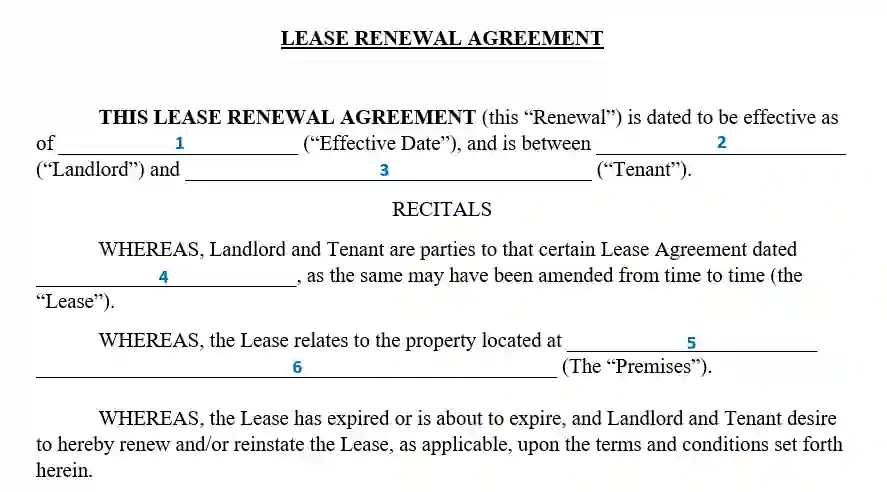
The first few paragraphs explain the cause of the new agreement and contain basic information. Add the following in the corresponding blanks:
- Blank 1: Date when the agreement was signed
- Blank 2: Full name of the landlord or lessor
- Blank 3: Full name of the tenant or lessee
- Blank 4: Write the date of the original lease agreement.
- Blanks 5 to 6: Input the complete address of the real estate property or unit (including the floor, house number, street name, county/city, state, and zip code). You may refer to the existing lease agreement for this.
Step 3— Choose the lease duration.

The next part involves the new lease term of your agreement. Choose any of the boxes, which fit your preference.
- Box 1: If your original lease agreement does not say anything about automatically converting to a month-to-month lease, you may tick this box. That is, of course, if you prefer a monthly renewal over a long-term lease.
- Box 2: Box 2 is a more secure option, giving a certain number of months for both the landlord and the tenant without an expiration. Instead, it will convert to a month-to-month lease until it is formally ended by both the landlord and tenant.
- Box 3: This option is good for continuing long-term or yearly leases. Similar to Box 2, it converts to a monthly agreement once the term ends.
- Box 4: This does not write a fixed duration. Instead, it contains the expiration date of the agreement.
Step 4— Add additional lease terms.
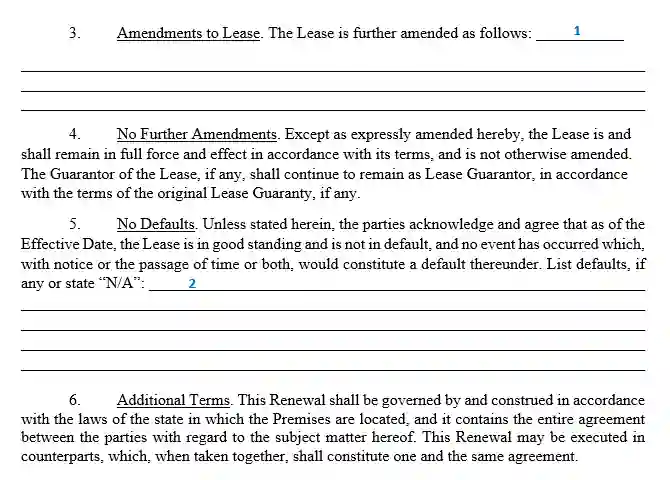
If the landlord or the tenant requests for some revisions to the existing lease agreement, these may be added on blank 1. The updated terms of the lease must be written as clearly and as detailed as possible to prevent any holes in the new agreement.
For additional defaults, write these on blank 2. It is best to consult a lawyer or any legal counsel if defaults will be revised as this will affect the entire contract.
Step 5— Type the parties’ information and sign the document.
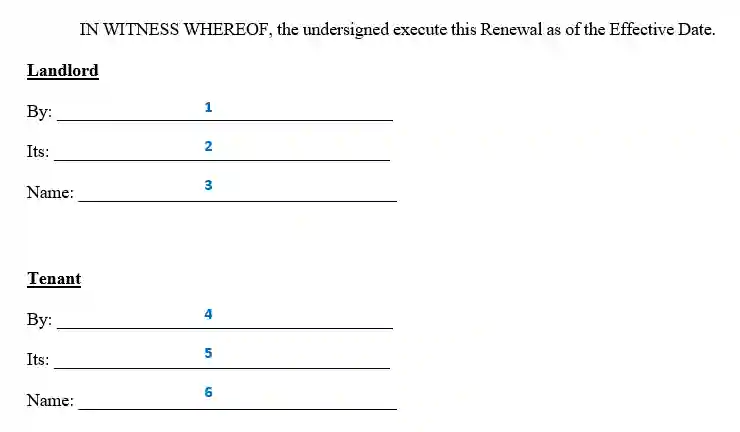
In this part, write the following:
- Blank 1: Landlord’s printed name and signature
- Blank 2: Landlord’s position in the company (if the property is owned by a company_
- Blank 3: Company name of the real estate property owner (if applicable)
- Blank 4: Printed name and signature of the tenant
- Blank 5: The position in the company of the tenant (if the property is being rented on behalf of a company)
- Blank 6: Tenant company name (if applicable)
Make sure that both the landlord and the tenant have signed on all pages of the document.
Renewing a lease does not need to be complicated, though you may end up using both a lease renewal letter and formal agreement. To renew the lease, both parties must finalize the new lease agreements before the old lease expires. Use FormsPal’s free template to simplify this process.
